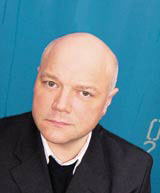Only Real Time will tell
Gabriel Murray has pioneered a virtual on-line network at his consultancy that allows staff to respond to the needs of the client quickly and efficiently

Since my first memories of computer-aided design from my early days at college using old IBMs and wall-plotters, I realised that this technology was destined to change the industry I was preparing to join.
I can remember being involved in stand-up rows over our first Apple Macintosh at Rodney Fitch in 1995 about information transfer, real-time client review, speed to manage the chore, and freeing up time for creative thinking. I also recall feeling how behind we were, compared to my previous experience in the US.
Although seemingly slow at first, things moved on. The Mac meant that we could start to work differently. We could scale the studio space down. The old space that used to be occupied by the design prima donna with a drawing board, a Hammerite trestle table, a Tizio lamp, a custom-coloured plan chest and the ubiquitous uplighter were no longer needed.
In 2002 I was planning my escape. I needed, and I think the industry needed, a new way of working – something that reflected the changing times and allowed a more effective and appropriate way of responding to the new retail market. I called the new way ‘the third way’. ‘You’ve tried the wrong way, you’ve tried the right way, now try the third way,’ a colleague mused. Murray 03 was launched on 3 March 2003 (03.03.03). Our third way is to work as virtually as possible: to avoid the shackles of a large studio; to be able to suit the needs of our clients directly; and to work at pace using technology to free time for quality thinking and the creation of real, workable solutions.
We’ve created an on-line virtual collective of ‘imaginators’, experts and creative realisers who are able to generate ideas, produce the technical information and join with clients in our version of the creative workshop – The Real Time Clique. This is an on-line gathering of the main interested parties, put together to formulate creative outputs.
The benefits are not only financial – our IT partner, New England Green, has been a godsend as the investment in hardware and software can be mind-boggling – but the cultural difference is immense. We can maintain constant contact with each other or be available for meetings, whether for an internal project review or a client presentation. All our technical information is broadcast to all parties and we have either constant or designated review time-slots. Our ‘project cliques’ are easier to arrange because we don’t have to physically get everyone together in one room.
Culturally, we have no design studio, but we do have a base both physical and digital. Generally though, we work from wherever we need to, allowing us to work closer to the deadline and still have the buddy factor by being able to chat to Mark or Helen on the top of the screen.
Now some may say that this is all very impersonal, but we can and occasionally do still use traditional methods. The point is, when things need to done right, and right now, we have the capability to make this happen.
Things to get rid of from the old-style design consultancy
• Linear work-space systems
• The goldfish bowl
• ‘Let’s socialise this one’
• Any light fitting ending in ‘o’
• Older design ‘gurus’ who should know better
-
Post a comment




